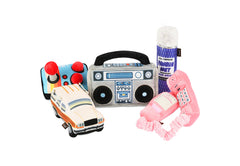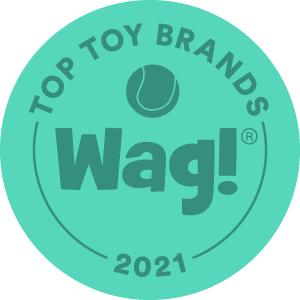Congratulations! Welcoming a puppy or dog into your life is the beginning of a beautiful adventure. Before you get lost in the cuddles and doggie kisses, carefully review our top 10 tips for first-time dog owners, starting with our new puppy checklist.
Tip #1 - Follow Our New Puppy Checklist
Getting a new puppy or dog is a bit like preparing for a new child — there's a lot of gear involved! Each of the following items is essential for the health and happiness of your growing puppy. Do keep in mind, even grown dogs should have these puppy-essentials — just in a bigger size.
- Appropriate dog food
We love our dogs like family, but they are not humans. They need quality food formulated for their specific biological needs, not ours.
- Dog bowls
You’ll want to pick up sturdy, easy-to-clean bowls for serving meals and providing a constant source of fresh, clean water.
- Healthy, rawhide-free puppy chews
Puppies and dogs need to chew. It eases the pain of teething and relieves stress like separation anxiety. Provide nutritious vet-recommended dog chews.
- Adjustable dog collar
If you can slip two fingers between the collar and your puppy's neck, and it's snug but not tight, you have the right fit.
- Name Tag
Add your puppy's name and your phone number to its name tag. Once your puppy is 6-8 weeks old, get a microchip. It's a painless procedure that ensures a lost dog returns home.
- Leash
A leash and the many walks you'll take together are vital for your puppy's health and happiness. Exercising together will form a bond that lasts a lifetime.
- Dog crate
Whether you plan to crate train or not, a sturdy crate for vet trips and a safe, enclosed space to retreat to is essential.
- Puppy blanket and plush toys
Puppies need to snuggle. It's a reminder of cuddling with mom and siblings, and it combats loneliness.
- Chew toys
Puppies and dogs don't chew your shoes or the furniture to annoy you. They need to chew! Provide safe, appropriate chew toys to redirect destructive chewing.
- Brush appropriate for the coat
Get your puppy accustomed to being brushed regularly and often. Don't think of it as a chore; it is bonding.
- Frozen pumpkin
Frozen pumpkin is a great treat to ease the pain of teething. And pumpkin soothes upset tummies while resolving both loose and hard stools for dogs of all ages.
Once you have the essential gear for your growing dog, the following tips will ensure both your dog and your relationship thrive!
Tip #2 - Respect for Doghood
Your dog will be a member of your family, but she deserves respect for her doghood. As Cesar Milan, The Dog Whisperer says, “Some people around dogs treat a dog like a human. Changing the identity of anybody creates instability.” And, “If you respect their identity, dogs give you respect back.” Keep your expectations sensible and dog-specific. Most behavior problems can be traced directly to a lack of training, poor nutrition, or the first-time dog owner's failure to understand a dog's needs. There is so much to learn! So our next tip is:
Tip #3 - Do Your Research
Dogs are so much fun, but they're not toys. They are complex beings with their own mental, emotional, and physical needs. As a first-time dog owner, put in the time to learn about dogs in general and your dog's breed in particular. You’ll find wonderful resources online as well as at the library. Your vet will be a tremendous source of information. The better you understand your dog's needs, the happier you'll both be.
Tip #4 - Find a Good Vet
Find a good vet you can talk to and get your first check-up together before there's ever a health problem. Prices and policies vary widely, so do some research upfront. Your vet is your partner in your dog's health care. First-time dog owners will learn a great deal about their dog's needs and how to manage their own expectations with each visit.
Tip #5 - Invest in Your Dog's Well-Being
Invest in your dog's health and well-being from day one. This means more than just buying every item on the new puppy checklist. Commit to the recommended schedule of check-ups and vaccinations with a vet you can talk to. Always choose a nutritionally balanced dog food formulated for your dog's age, size, and activity level. Also provide safe, rawhide-free, chew toys and vet-recommended dog chews. These kinds of chews are great for your dog's training, exercise, and social needs,
Tip #6 - Keep Moving
Walk, run, play Frisbee--Whatever form the exercise takes, your new dog needs plenty of it on a daily basis. Dr. Susan Nelson, K-State veterinarian and assistant professor of clinical sciences, says, “Dogs also need an outlet to relieve their energy or else they may develop destructive behavior. Your dog is going to be happier and more content if it receives adequate exercise.” The amount of exercise varies depending upon the size, breed, and age of your dog. Ideally, all dogs will get two periods of exercise daily, that range from 15 - 60 minutes, depending upon these variables.
Tip #7 - Dog Training is Essential
First-time dog owners often cringe at the idea of dog training. They don't want to be bossing their new friend around, but this is entirely the wrong perspective. Training based on positive reinforcement vastly improves the communication between the two of you. Your dog will feel much more confident and secure with a clear understanding of your expectations.
Tip #8 - Choose the Right Chews
All dogs have an innate need to chew. It's not a "bad habit" or behavioral problem. Chewing alleviates stress and anxiety while providing mental stimulation and combating boredom. Always provide appropriate chew toys and treats like vet-recommended dog chews to redirect destructive chewing. The ideal size for chew toys and treats is just a bit larger than your dog's mouth.
Tip #9 - Get Social
Like us, dogs are social animals. They enjoy meeting and greeting other dogs and people. The more experience they have with others, the better these interactions will go. If you're away from home for long stretches, have a dog-walker visit. A bored, isolated dog is an unhappy dog, and that's when behavioral issues arise. Build socializing time into your routine.
Tip #10 - Create a Routine
Dogs thrive on routine. Familiar patterns are comforting, and they quickly learn to anticipate them. Offer food, walks, socializing, training, and playtime at roughly the same times each day.
Don't be intimidated by the length of our new puppy checklist or the rest of these tips for first-time dog owners. You are embarking on one of the most rewarding relationships of your life. Your dog will reward your preparation with a lifetime of love, health, and happiness. A treasure, indeed!
About the Author:
At NutriChomps, we know that pets are an integrated part of the family! We pride ourselves on our understanding of dogs, their needs, and what is best for their health and overall happiness. The NutriChomps team provides updated information on alternatives to rawhide products. Now your dogs can continue enjoying their chew time without sacrificing digestive health. Visit nutrichomps.com for more information on rawhide-free chews.






